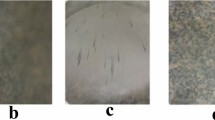Abstract
Biopolymers and biopreservatives produced by microorganisms play an essential role in food technology. Polyhydroxyalkanoates and bacteriocins produced by bacteria are promising components to safeguard the environment and for food preservation applications. Polyhydroxybutyrate (PHB)-based antimicrobial films were prepared incorporating eugenol, from 10 to 200 μg/g of PHB. The films were evaluated for antimicrobial activity against foodborne pathogens, spoilage bacteria, and fungi such as Staphylococcus aureus, Escherichia coli, Salmonella typhimurium, Bacillus cereus, Aspergillus flavus, Aspergillus niger, Penicillium sp., and Rhizopus sp. The synergistic antimicrobial activity of the films in the presence of crude pediocin was also investigated. The broth system containing pediocin (soluble form) as well as antimicrobial PHB film demonstrated an extended lag phase and a significant growth reduction at the end of 24 h against the bacteria. Crude pediocin alone could not elicit antifungal activity, while inhibition of growth and sporulation were observed in the presence of antimicrobial PHB film containing eugenol (80 μg/g) until 7 days in the case of molds, i.e., A. niger, A. flavus, Penicillium sp., and Rhizopus sp. in potato dextrose broth. In the present study, we identified that use of pediocin containing broth in conjunction with eugenol incorporated PHB film could function in synergized form, providing effective hurdle toward food contaminating microorganisms. Furthermore, tensile strength, percent crystallinity, melting point, percent elongation to break, glass transition temperature, and seal strength of the PHB film with and without eugenol incorporation were investigated. The migration of eugenol on exposure to different liquid food simulants was also analyzed using Fourier transform infrared spectroscopy. The study is expected to provide applications for pediocin in conjunction with eugenol containing PHB film to enhance the shelf life of foods in the food industry.




Similar content being viewed by others
References
Han, J. H. (2000). Food Technology, 54, 56–65.
Cooksey, K. (2005). Food Additives and Contaminants, 22, 980–987.
Weng, Y. M., Chen, M. J., & Chen, W. (1999). Lebensmittel-Wissenschaft und Technologie, 32, 191–195.
Padgett, T., Han, I. Y., & Dawson, P. L. (1998). Journal of Food Protection, 61, 1330–1335.
Hoffman, K. L., Han, I. Y., & Dawson, P. L. (2001). Journal of Food Protection, 64, 885–889.
Burt, S. (2004). International Journal of Food Microbiology, 94, 223–253.
Marathe, R. (2008) M.Sc thesis, Rutgers, The State University of New Jersey
Pranoto, Y., Rakshit, S. K., & Salokhe, V. M. (2005). LWT, 38, 859–865.
Hitokoto, H., Morozumi, S., Wauke, T., Sakai, S., & Kurata, H. (1980). Applied and Environmental Microbiology, 39, 818–822.
Farag, R. S., Daw, Z. Y., Hewedi, F. M., & El-Baroty, G. S. A. (1989). Journal of Food Protection, 52, 665–667.
Pinto, E., Vale-Silva, L., Cavaleiro, C., & Salguiero, L. (2009). Journal of Medical Microbiology, 58, 1454–1462.
Pol, I. E., & Smid, E. J. (1999). Letters in Applied Microbiology, 29, 166–170.
Gonzalez, S. L., Vargas, M., Martinez, C. G., Chiralt, A., & Chafer, M. (2011). Food Engineering Reviews, 3, 1–16.
Ettayebi, K., Yamani, J. E., & Rossi-Hassani, B. D. (2000). FEMS Microbiology Letters, 183, 191–195.
Jin, T., & Zhang, H. (2008). Journal of Food Science, 73, 127–134.
Nonsee, K., Supitchaya, C., & Thawien, W. (2011). International Food Research Journal, 18, 1531–1541.
Narayanan, A., & Ramana, K. V. (2012). Biotechnology, 2, 287–296.
Smith-Palmer, A., Stewart, J., & Fyfe, L. (1998). Letters in Applied Microbiology, 26, 118–122.
Galet, V. M., Lopez- Carbello, G., Gavara, R., & Hernandez- Munor, P. (2012). International Journal Food Microbiology, 157, 239–244.
Patil, M. M., Pal, A., Anand, T., & Ramana, K. V. (2010). India Journal Biotechnology, 9, 166–172.
Neera, Patil M.M., Ramana K.V and Bawa A.S. (2013). Journal of Food Processing and Preservation 7, 179–187.
Kim, C. H., Ji, G. E., & Ahn, C. (2000). Food Sciences Biotechnology, 58, 400–405.
CEN 2004.EN 13130-1: Materials and articles in contact with foodstuffs—plastics substances subject to limitation—part 1: Guide to test methods for the specific migration of substances from plastics to foods and food simulants and the determination of substances in plastics and the selection of conditions of exposure to food simulants. CEN, Brussels.
Olcay, A. (1968). Communications. De La Facullte Des Sciences De L’Universite D’Ankara.
Appendini, P., & Hotchkiss, J. H. (2002). Innovation Food Science Emerging Technology, 3, 113–126.
Suppakul, P., Miltz, J., Sonneveld, K., & Bigger, S. W. (2003). Journal of Food Science, 68, 408–420.
Hammer, K. A., Carson, C. F., & Riley, T. V. (1999). Journal of Applied Microbiology, 86, 985–990.
Ultee, A., Gorris, L. G. M., & Smid, E. J. (1998). Journal of Applied Microbiology, 85, 211–218.
Kalemba, D., & Kunicka, A. (2003). Current Medicinal Chemistry, 10, 813–829.
Jung, D. S., Bodyfelt, F. W., & Daeschel, M. A. (1992). Journal of Dairy Science, 75, 387–393.
Ghalfi, H., Benkerroum, N., Doguiet, D. D. K., Bensaid, M., & Thonart, P. (2006). Letters in Applied Microbiology, 44, 268–273.
Maizura, M., Fazilah, A., Norziah, M. H., & Karim, A. A. (2007). Journal of Food Science, 72, 1–7.
Go´mez-Estaca, J., Lo´pez de Lacey, A., Lo´pez-Caballero, M. E., Go´mez-Guille´n, M. C., & Montero, P. (2010). Food Microbiology, 27, 889–896.
Perez, C., Gonzalez, R., Rodriguez, C.A., Rodriguez, B.J.R., Oretaga, V.F. (2006) Adv. Agri. Food Biotechnol. pp. 193–216.
Acknowledgments
The authors would like to thank Dr. H.V. Batra, Director, and Dr. V.A. Sajeevkumar, Defence Food Research Laboratory, Mysore, India, for their kind help and encouragement during the research work.
Author information
Authors and Affiliations
Corresponding author
Rights and permissions
About this article
Cite this article
Narayanan, A., Neera, Mallesha et al. Synergized Antimicrobial Activity of Eugenol Incorporated Polyhydroxybutyrate Films Against Food Spoilage Microorganisms in Conjunction with Pediocin. Appl Biochem Biotechnol 170, 1379–1388 (2013). https://doi.org/10.1007/s12010-013-0267-2
Received:
Accepted:
Published:
Issue Date:
DOI: https://doi.org/10.1007/s12010-013-0267-2




